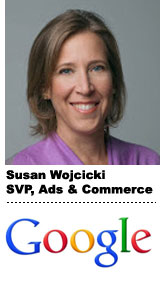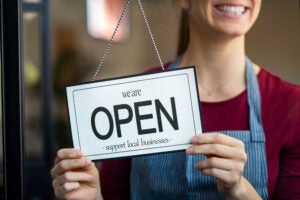 Web publishers using Google’s AdSense program will get new ad formats and better tools for optimizing ads on their sites in coming months and years, Google’s ad chief promised Monday.
Web publishers using Google’s AdSense program will get new ad formats and better tools for optimizing ads on their sites in coming months and years, Google’s ad chief promised Monday.
Susan Wojcicki, Google’s senior vice president of advertising and commerce, hinted at the improvements during a live video Google Hangout on Tuesday celebrating the official 10th anniversary of AdSense, which launched under that name on June 18, 2003. The self-service program, which runs ads matching the content of a Web page, actually began a few months earlier as “Content-Targeted Advertising,” but when Google bought Applied Semantics in April 2003, it renamed the contextual ad service using that firm’s AdSense moniker for a similar service.
AdSense has since become a prime means of support for many Web sites, and it even supplements ads on large sites such as the New York Times and, more recently, Yahoo. The program paid out $7 billion to some 2 million publishers last year, about two-thirds of the total ad revenues AdSense brings in. Wojcicki said Google issues about 100,000 AdSense checks a month, “probably more than most Fortune 500 companies.”
Not surprisingly, given Google’s penchant for keeping future plans close to the vest, Wojcicki didn’t make specific product announcements. But she outlined a couple of general directions for AdSense.
For one, she said, the company will “innovate a lot” in new ad formats as the way people go online and what they do there continues to evolve. “Our goal for AdSense is wherever users are going, we want to enable a monetization solution,” she said, whether it involves apps, video, mobile, or wearable devices.
But she said Google aims to continue focusing on native formats that fit the context of users’ activities. For instance, she mentioned YouTube’s TrueView ads, which viewers can skip after a few seconds and which advertisers pay for only if the ads are watched for at least 30 seconds. She also referenced Engagement Ads, such as the Lightbox ad format that can expand to full screen to allow advertisers to embed catalogs or even video streams. Wojcicki didn’t provide a timetable but said they eventually would come to AdSense.
Wojcicki also said mobile will be a big priority, as it is throughout Google. “We think of advertising as information — How do we service the right information to people when they want it?” she said. “We’ll continue to see mobile becoming really substantial, so we’re looking to see how we can take advantage of that.”
Google also plans to provide small and medium-sized AdSense publishers with more tools for optimizing ad placement and frequency. Google now sends semi-customized tips to groups of publishers, such as suggesting more ads could be run on a page or identifying a particular part of the page where an ad would be more effective. Wojcicki sketched out a much more automated future for such tools. “Ideally, you could push a button and everything automatically optimizes,” she said. “We’re working on it.”
Overall, she said in a theme she has sounded before, the main challenge for Google and AdSense in particular is to make it as easy for advertisers and agencies to run ads in various online channels as it is to tun them in TV and print. “Marketers can move tens or hundreds of millions of dollars very easily” in those channels, she said, so Google’s goal is to give advertisers similar control, reach, and measurement with online ads.











